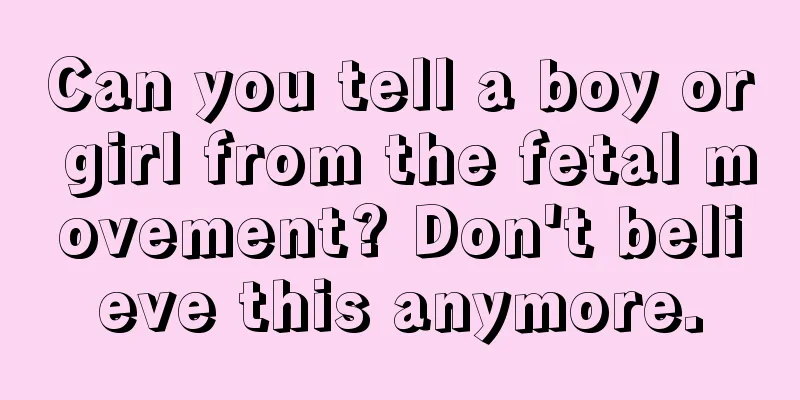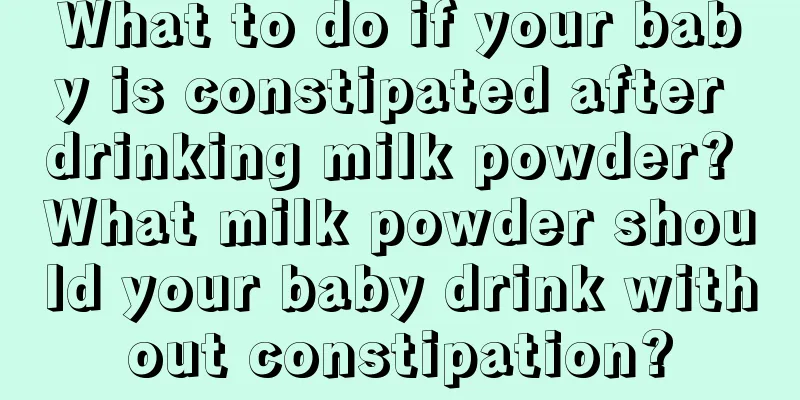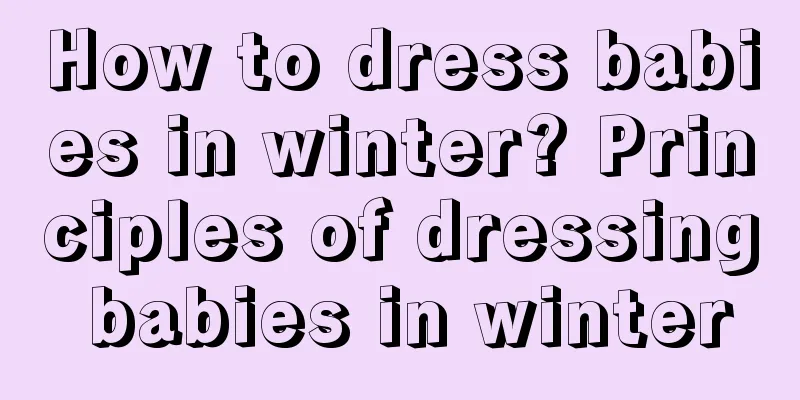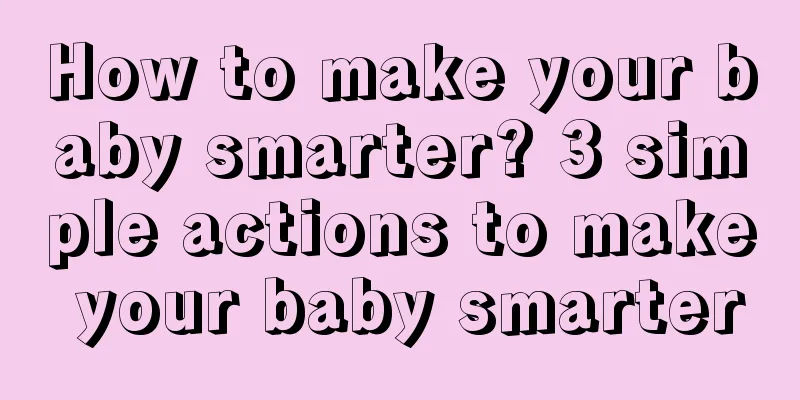How to buy clothes for your baby? A guide to buying clothes for your baby
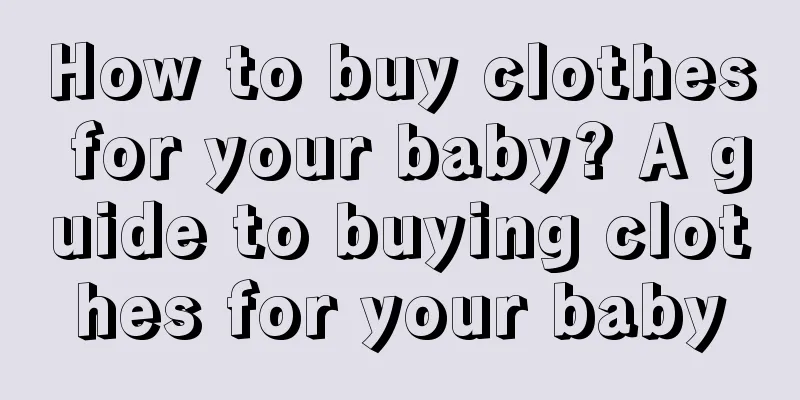
|
Buying clothes for babies is a headache for many mothers, and it is even more troublesome than buying clothes for themselves. Many times, after comparing prices from three stores and carefully selecting the clothes, mothers find that the clothes are either too long or too short, too big or too small when they get home. Why are the clothes bought for babies always not right when they wear them? Let's take a look at a personal guide to buying clothes for babies. How can I buy the right one?Today, Junjun has launched a set of "baby clothes" purchase and dressing guides for mothers. Just buy and wear as directed, and you'll be right! size: Baby clothes are sized in 3-month intervals: 0-3 months, 3-6 months, 6-9 months, 9-12 months. Theoretically, it is reasonable to buy clothes of "0-3 months" size for newborns (babies from delivery, umbilical cord ligation to 28 days old). However, when you put the clothes on your baby, you find that the sleeves are too tight. This is because you ignored the actual growth rate of your baby. Today's babies are well-nourished and well-developed. Therefore, before you go out to buy clothes, look at your baby's body during this period, rather than buying them strictly according to theoretical standards. Fabric: Cotton, easy to clean, soft and comfortable clothes are your first choice. Pay attention to the attribute "easy to clean" that I ranked second. Baoma must pay attention to it. Because the speed at which you change clothes can never keep up with the speed at which your baby pees or spits up and stains the clothes. To protect your hands, it is a good idea to buy clothes that are easy to wash. Safety We have zero tolerance for any clothes that may pose a "potential threat" to the baby's safety. Clothes with buttons, strings, and straps. We should buy clothes for babies based on the principle of "the simpler the better". Sometimes it's because we don't realize the potential problem. I've treated many babies who accidentally swallowed buttons and were rushed to me with purple faces. I'm still scared when I think about it. You may think that buttons are sewn on clothes, so they are not easy to fall off. Don't think so. How can you ensure that the buttons are sewn so firmly? In addition, buttons are very easy to fall off due to constant washing, and they are easily caught by babies. Strings and straps on clothing can cause your baby to get tangled in objects in your home and cause strangulation. Don’t ignore the details when buying clothesAny details related to the baby's safety should not be taken lightly, and should be avoided when buying clothes! Easy to put on and take off: change it after peeing or pooping. If the clothes are difficult to put on and take off, the collar is too small and it gets stuck on the neck when taking off the top, and the baby can't get on or off; the sleeves are too narrow and the baby's arms can't stretch out. If you make him uncomfortable, don't blame him for making trouble with you. When buying clothes, choose loose sleeves; clothes made of elastic fabrics and with front openings are also acceptable. Don't choose clothes with zippers. I don't want to experience the feeling of being pinched by a zipper a second time. Don't let this painful accident happen to your baby. The above are the requirements for a single piece of clothing. Only when it meets the requirements can it be worn by the baby. In addition, I have prepared some clothes that the baby often wears for reference by mothers. Pajamas: In summer, you can put a soft, breathable one-piece or long pajamas on your baby. Long pajamas have a unique advantage, which is that they can protect the baby's abdomen. The baby will not catch a cold by kicking off the quilt. In winter, you can put thicker cotton pajamas on your baby. Here, Junjun would like to remind mothers that the size of baby's pajamas must be just right and not too large. When babies are not sleeping well, they are prone to pull the pajamas, blocking their mouths and noses, and there is a risk of suffocation. Suit: When you take your baby out, a suit is the best protective clothing for him. When you wear a suit that can be buckled at the waist, the pants will not slide down and the top will not rise up no matter you carry him on your back or hold him in your arms. The abdomen will not get cold. Socks: The biggest problem with socks is that they fall off easily. I often pick up socks that babies drop in the clinic. They may be rubbed off by the baby's grunting or pulled off by the baby's hands. Mothers should choose socks that can be worn, and should not choose socks that are too tight just to prevent the socks from falling off. All choices should be based on the comfort of the baby's feet. hat: It can keep you warm in winter and block the sun in summer. Again, the size should be just right. If it is too big, it will cover your eyes and affect your vision; if it is too small, it will get stuck on your head and hurt. shoe: When babies start to walk, they should wear low-top shoes with soft soles and non-slip. When buying shoes, mothers should test them by hand. Bend the sole to see if it is soft enough and feel the non-slipness of the sole with the palm of your hand. The upper should be breathable and the material should be lightweight. After all, babies are just learning to walk and their steps are unstable. Light shoes can reduce the resistance when they take steps. Washing clothes: Before the baby wears new clothes, the mother should wash them to prevent the irritating substances on the clothes from hurting his skin. When washing dirty clothes, soak them first and then wash them. You have to be careful to avoid stains sticking to your clothes first. When choosing detergents, use those labeled "special detergent for baby clothes." Detergents designed specifically for babies contain natural ingredients that will not irritate baby's skin. When buying clothes for your baby, buying the right one is the premise, and dressing the baby right is the ultimate goal of the mother. But there are always some special situations that make you feel at a loss when dressing your baby. In view of the two most common "special situations", Junjun provides mothers with a "dressing guide" to deal with them. Guide to dressing your baby when he or she has a feverUnder normal circumstances, the human body temperature is constant at 37℃. When you are sick, the hypothalamus temperature regulation center raises the body temperature, and the body will have a fever. After the temperature regulation center raises the body temperature, we will feel cold. The body will produce heat through shivering, and at the same time, the blood vessels in the skin will contract to reduce heat dissipation, so the baby will feel cold and have cold hands and feet. When the baby is cold, put clothes on him and cover him with a blanket until he feels no longer cold. After the baby takes antipyretic medicine, the body temperature is adjusted back to around 37℃. At this time, the actual body temperature is higher than the "adjusted back" temperature, and the body will stop shivering and dilate the blood vessels in the skin to dissipate heat. When the baby is hot, you should reduce the clothes and quilts on him to help dissipate heat and help cool down. If you blindly cover him with clothes and quilts, the heat generated by the body cannot be dissipated and the body temperature cannot return to normal. Put it on when it's cold and take it off when it's hot, with the baby's comfort as the principle. Here, mothers should pay special attention and observe babies who can't speak carefully. Dress according to the weather When I see babies, I find that they always wear more clothes than they actually need. In fact, it is enough to let your baby wear the same number of clothes as you, or wear an extra thin layer. Secondly, in weather above 24℃, it is enough to put one layer of clothes on your baby. Babies do not sweat easily, and wearing too much clothes will cause overheating. When your baby is in an air-conditioned room, you can put on an extra layer of clothes. Before going out, don't forget to put a hat on your baby and put on clothes to cover his skin. Finally, Junjun would like to say that referring to these guidelines, buy clothes based on your baby's physical development. Dress flexibly according to the weather and temperature! |
<<: Will a bad mood aggravate stomach problems? Can depression cause stomach problems?
Recommend
How to coax your baby to sleep and how to make your baby fall asleep quickly
How to make your baby fall asleep quickly is a di...
Causes of Unplanned Pregnancy 15 Ways to Get Pregnant Unplannedly
Unexpected pregnancy is a phenomenon that many yo...
How should pregnant women protect themselves from radiation? What should pregnant women eat to protect themselves from radiation?
With the development of modern technology, radiat...
Can I turn on the air conditioner when my baby is coughing in the summer? Can I turn on the air conditioner when my baby is coughing in the summer?
Can you use the air conditioner when your baby is...
Will ultrasound harm the baby? Listen to the doctor and there will be no danger
Every pregnant mother knows that during the prena...
Can drinking red wine help you have a boy? Can drinking red wine help you have a boy?
Some parents who are planning to have a baby want...
What are the best names for boys born in the Year of the Rat? List of names for boys born in the Year of the Rat in 2020
In one month, the 2020 Rat baby will be born. For...
Can I lose weight during confinement? How can I lose weight during confinement?
Many postpartum mothers want to get back in shape...
What causes hiccups in newborns? What to do if a newborn hiccups
Newborns usually need careful care from their mot...
What is the process of artificial insemination and what are the methods?
Getting pregnant and having a baby is the dream o...
What to do if your baby can't sit still while eating
Educating children is a very headache thing for m...
What should I do if my baby has bald spots on his head? How can I improve the phenomenon of bald spots on my baby's head?
Newborn babies are prone to baldness on the back ...
What if I have big breasts but little milk? What should I do if I have big breasts but no milk?
Many parents believe that the size of the breasts...
Can humidifiers cause respiratory diseases? What are the benefits of humidifiers to the body?
Although humidifiers are good for the human body,...
The correct treatment of breast engorgement during weaning helps mothers quickly relieve the pain of breast engorgement
After weaning, not only will the baby be unable t...
